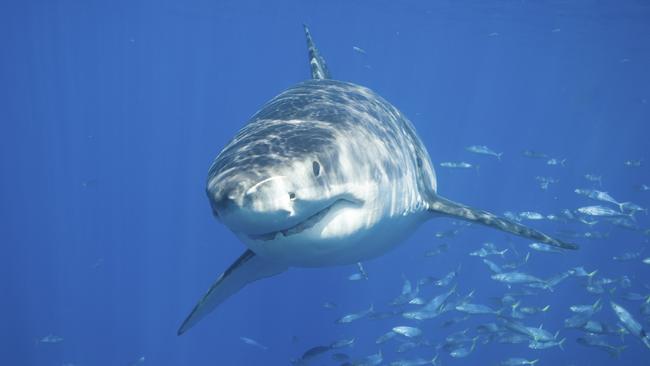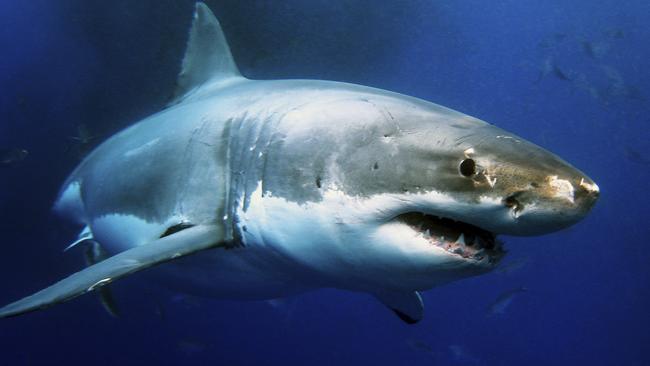Australia has recorded its highest number of shark attack deaths in three decades. Why?
“Go to the Gold Coast Broadwater, swim along the edge of a drop-off after a lot of rain, among baitfish with dogs,” he said.
GOLD COAST PADDLER STALKED BY 3.5M SHARK
“Your chances of meeting a bull shark should be good.
“Dogs don’t necessarily attract sharks but they help with the commotion.
“And you know what? Hundreds of people do it all the time.’’
McPhee, an associate professor at the Gold Coast’s Bond University, is researching the global incidence of shark attacks.

He’s looking at why attacks occur like the two in northern NSW over the past week, and what can be done to reduce the incidence.
In the past three decades, Australia has had more people die from shark attack than any nation. Thirty-two people died between 1982 and 2011, a threefold increase on earlier figures. Surfers are the group most often attacked, followed by swimmers and scuba divers.
Theories abound on why attacks are increasing.
One is that the return of large numbers of migrating whales, seals and sea lions — dominant shark prey — might be attracting predators. Great white sharks tend to follow whale migrations along the so-called Humpback Highways off the east and west coasts.
Another is that hotter temperatures, a growing population and more leisure time now see more people in the water bumping into these creatures.
Southern Cross University shark expert Dr Danny Bucher says the fact a great white killed Ballina surfer Tadashi Nakahara this week was unusual in that they mostly appear in winter. Regardless, it is a warning they can appear any time.
Bull sharks, great whites and tigers are the three species implicated in most attacks, although an increase in their numbers is not reflected in data from the Federal Environment Department or Queensland Shark Control Program.
Queensland’s shark-culling program using drum lines and nets since 1962 has killed thousands of sharks. It was used as the justification for WA’s shark cull last year after a rash of attacks.
University of Western Australia researcher Professor Jessica Meeuwig went through the Queensland figures, finding claims of any increase in human safety were at best doubtful based on attack data before and after the program.
Moreover, 60 per cent of sharks caught in nets were found to be heading back out to sea, which shows how ineffective netting is. But a 2006 Queensland Government review deemed shark nets and drum lines effective, noting only one fatality on a netted beach in 44 years.

A public uproar ended WA’s culling which killed 68 sharks. Ironically, none were the vulnerable great whites, the most-feared species.
Between 1853 and 2013 there were at least 71 fatalities after shark attacks in Queensland, with most of these attributed to tiger sharks and one to a great white.
Bucher sees no evidence to support the view of Hervey Bay shark hunter Vic Hislop that fishing has depleted other species, prompting sharks to change diet. Sharks have not evolved with any particular taste for human flesh.
Scientists also wonder if an increase in WA and SA white shark attacks might be linked to so-called adventure tourism. Viewing cages containing tourists are lowered into the water and bait is put out to attract sharks, raising fears this might be changing shark behaviour.
Queensland has had a low rate of shark bites over the past couple of decades despite Dan Smith, 18, dying off the Daintree in December and Sarah Whiley, 21, being taken off North Stradbroke Island in 2006.
But McPhee warns it is unwise to view Queensland as safe.
In fact it could be the reverse. In the 1950s celebrity fishers Bob and Dolly Dyer held several world records for the biggest whites and tigers which were caught in Moreton Bay.
Sharks hung around Brisbane’s doorstep because of the gore from Moreton Island’s Tangalooma whaling station. As well, one of the three east coast aggregation sites for great white juveniles is off Fraser Island. The others are off Newcastle, NSW, and Lakes Entrance, Victoria.
The old idea of shark enclosures remains effective for swimmers and at times like this in our weather cycle, people should show more caution, says McPhee. People have to take responsibility for when and where they enter the water.
“Don’t go night swimming. You make yourself very attractive fish bait,’’ he says. “A guy who had been drinking went skinny dipping in the Parramatta River lost a testicle and part of a leg after he landed on a bull shark’s face.’’
Despite many gory stories, McPhee says shark bite remains an extremely rare way to die. Humane Society International spokeswoman Alexia Wellbelove and Bucher agree. Between 2001 and 2005, 129 people drowned on Australian surf beaches while five died from shark bite.
“The greatest danger in going to the beach is getting in the car, then drowning, then being hit in the head by a surfboard or something and then maybe a shark,’’ Bucher says.
McPhee says it’s time authorities warned about dangerous shark conditions just as Surf Life Saving Australia warns about dangerous swimming conditions.


Add your comment to this story
To join the conversation, please log in. Don't have an account? Register
Join the conversation, you are commenting as Logout
Sharks unveil huge new stadium, $500m mega development
Southport Sharks has unveiled plans for a near-21,000-seat stadium and three residential towers in a massive redevelopment that could reshape the Gold Coast's sporting landscape.
Revealed: All Coast’s options for solving gridlock nightmare
The Gold Coast's population will surge by 350,000 in two decades, but the city's transport blueprint remains in limbo after light rail's dramatic cancellation. FIND OUT MORE